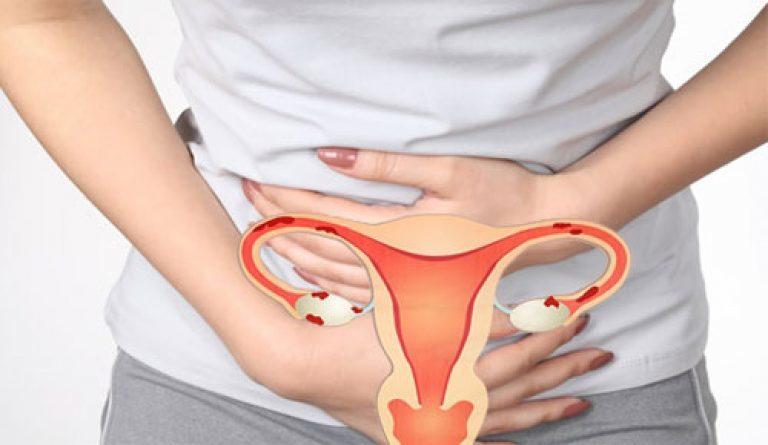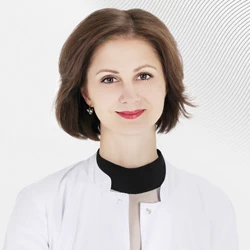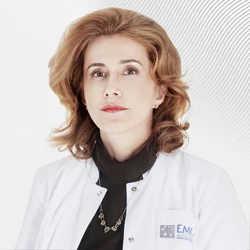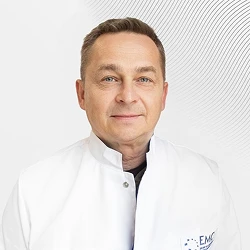Endometriosis — symptoms and treatment
Endometriosis is a chronic, recurrent, progressive disease characterized by benign overgrowth of the uterine mucosa outside the uterine cavity. Pathology ranks third among all gynecological diseases in terms of frequency of occurrence. In most cases, it manifests itself in childbearing age. If left untreated, it leads to the development of cicatricial adhesions in the pelvis, endometrioid ovarian cysts, and infertility. In rare cases, malignant degeneration of endometriosis foci is diagnosed.

Causes of endometriosis in women
What causes a female disease - endometriosis of the uterus? Researchers have different opinions about the causes of endometriosis. Most specialists adhere to the implantation theory (the theory of retrograde menstruation), according to which, during menstruation, endometrial particles enter the fallopian tubes, abdominal cavity, and pelvic organs, attach to tissues and continue to function, causing microbleeds and inflammation. Some authors point to gene mutations, changes in the function of cellular enzymes, and hormonal disorders as the causes of the pathological overgrowth of the endometrium.
All women have retrograde menstruation, but the likelihood of endometriosis increases in the presence of predisposing factors, which include:
- burdened heredity;
- surgical interventions on the organs of the reproductive system;
- immune suppression;
- metabolic disorders;
- intrauterine contraception;
- hormonal imbalance;
- The vision.
The high-risk group includes women over the age of thirty who have had abortions, cesarean sections, cauterization of cervical erosions, and family cases of endometriosis in their mother and grandmother.
Classification and degree of development of endometriosis
Clinical manifestations of endometriosis largely depend on the localization of endometrial foci (heterotopias), in connection with which the genital and extragenital forms of the disease are distinguished.
In the genital form, heterotopias do not spread beyond the reproductive system; in the extragenital form, they occur in the intestines, bladder, kidneys, lungs, and in the area of postoperative scars. Depending on the localization of heterotopias in the genital form of the disease, the following are distinguished:
- peritoneal endometriosis — affects the ovaries, pelvic peritoneum, fallopian tubes;
- Extraperitoneal endometriosis is localized in the vagina, cervix, rectovaginal septum, and external genitalia;
- adenomyosis (endometriosis of the uterus) develops in the muscular layer of the uterus, which causes it to increase in size and become spherical.
There are four degrees of disease development in the clinical picture, each of which is characterized by the prevalence and depth of the lesion:
- Grade I — single surface foci occur;
- Grade II — the number of heterotopias and the depth of tissue damage increase:
- Grade III — multiple deep foci and endometrioid cysts are observed, the adhesive process develops;
- Grade IV — examination reveals multiple heterotopias, dense adhesions, germination of the uterine mucosa into the walls of the vagina and rectum, and large bilateral endometrioid cysts.
Endometriosis of the uterus of the III–IV degree is less treatable, often leads to infertility, and when pregnancy occurs, it can provoke miscarriage. After treatment, the probability of conception in the first 12 months increases to 50-55%.
Endometriosis — symptoms of the disease and how it manifests itself
The disease can be asymptomatic for a long time, and often a woman is not even aware of the presence of health problems. Preventive gynecological examinations and screening programs for women help to identify endometriosis in the early stages.
The following signs help to suggest the development of the disease in the early clinical stages:
- Painful menstruation. Pain in the first days of the menstrual cycle is the most common symptom that occurs in 40-60% of patients. The causes of painful menstruation, as a rule, are spasm of the uterine vessels, hemorrhage into the cyst cavity, irritation of the peritoneum.
- Violation of the menstrual cycle. Menorrhagia (profuse painful menstruation) is observed in 10-15% of patients, often occurs with adenomyosis and the presence of concomitant pathologies of the reproductive system.
- Pain in the lower abdomen. Pelvic pain in endometriosis occurs in 20-25% of cases. The pain syndrome may be local or diffuse, may increase during sexual intercourse, urination, defecation, before menstruation, or constantly disturb. As a rule, the cause of pain is inflammation that occurs in the affected organs.
- Posthemorrhagic anemia. Due to chronic blood loss, hemoglobin levels decrease in patients with endometriosis. Posthemorrhagic anemia develops, which is accompanied by weakness, fatigue, pallor of the skin, and dizziness.
Infertility in endometriosis develops in 25-40% of cases. Obstetricians and gynecologists do not have a clear answer as to why the disease leads to impaired fertility. However, there are many known mechanisms by which endometrioid lesions contribute to changes in the ovaries and fallopian tubes, decreased general and local immunity, and menstrual cycle disorders. They interfere with conception by reducing the activity of spermatozoa in the fallopian tubes and uterine cavity.
Complications of endometriosis
Long”term endometriosis causes the formation of endometrioid cysts in the ovaries, scars and adhesions in the pelvic organs and abdominal cavity, in the last stages endometrioid infiltrates form with the germination of the rectum, ureters, “frozen pelvis" and as a result, infertility.
Extensive pathological foci can compress nerve endings and cause neurological disorders, such as discomfort in the pelvis and lower extremities, paresthesia, and chronic pain.
The malignant degeneration of endometriosis remains an unresolved scientific and clinical problem. According to various medical sources, malignancy of pathology occurs in 0.6–11.4% of patients with genital form. The prognosis of the disease is better than with conventional epithelial malignant tumors of the ovaries. The five-year survival rate for nondisseminated forms is 65%.
Diagnostics
The symptoms of endometriosis are not specific and may occur with other gynecological diseases. A comprehensive examination of the patient helps to make an accurate diagnosis, which may include:
- Medical history collection. At the initial appointment, the doctor talks with the patient: he finds out what is bothering her, when the first signs of the disease appeared, and collects a gynecological history.
- Gynecological examination. Examination on a gynecological chair allows you to determine the increase in size, limitation of mobility of the uterus and ovaries, and detect extraperitoneal endometriosis. Based on the survey and examination data, the doctor prescribes instrumental and laboratory tests to confirm the diagnosis and draw up a treatment plan.
- Colposcopy. Examination of the vaginal part of the cervix using a colposcope is performed during the examination by an obstetrician-gynecologist on a gynecological chair.
- Hysterosalpingography. An echographic examination using a contrast agent allows you to assess the condition of the uterus and the patency of the fallopian tubes. With endometriosis, lesions and adhesions in the reproductive organs and pelvic organs may be detected during hysterosalpingography.
- Magnetic resonance imaging and computed tomography. MRI and CT scans are prescribed to clarify the location, nature, and depth of the lesion. Diagnostic accuracy reaches 96%.
- Ultrasound of the pelvic and abdominal organs. Ultrasound examination is performed to clarify the localization of lesions and evaluate the effectiveness of treatment. It can be used as an alternative when other research methods are not available or contraindicated in the patient.
-
Diagnostic laparoscopy. Laparoscopic examination is a highly informative method that allows you to visualize foci of endometriosis, assess their number, activity, and degree of maturity. To confirm the diagnosis during
- Laboratory diagnostics. To confirm the diagnosis of endometriosis and assess the general condition of the patient's body, laboratory tests are prescribed: clinical and biochemical blood tests, cancer marker research: REA, SA-125, CA 19-9, RO-test.
The diagnostic program is designed individually for each patient, so it may include other studies, as well as consultations with specialists in related fields. Based on the results of a comprehensive diagnosis, the doctor makes a diagnosis and draws up a treatment plan.
Endometriosis treatment methods
When choosing treatment tactics for a gynecological disease, the doctor is guided by several parameters: the localization and prevalence of the pathological process, the depth of the lesion, the patient's age, medical history, the presence of concomitant diseases.
Conservative treatment
Drug treatment of endometriosis (without surgery) is indicated in the early stages of the disease, with an asymptomatic course, at a young age of the patient, during premenopause. The leading place in drug therapy is given to hormonal drugs of the latest generation of progestogens. Gonadotropin releasing hormone agonists are used only in extremely severe recurrent forms of endometriosis.
In addition to the main treatment, the patient may also be prescribed immunostimulants, antispasmodic and analgesic drugs, and anti-inflammatory drugs.
Surgical treatment
Removal of foci of pathological tissue surgically is the most effective method of treating grade II–IV endometriosis. Preference is given to minimally invasive surgical procedures, which are highly effective but less traumatic for the patient. In all cases, laparoscopy is the gold standard of surgical treatment of endometriosis worldwide!
Regardless of the depth and prevalence of the pathological process, doctors try to preserve healthy tissues and reproductive function as much as possible. Radical operations with the removal of the uterus and appendages are performed only in extreme cases: patients over the age of 50 with children, with active rapidly progressive endometriosis, and without the effect of medication and gentle surgical treatment.
Prevention of endometriosis
There is no specific prevention of pathology. Preventive examinations by a gynecologist help to identify the disease at an early preclinical stage. To reduce the risk of developing pathology, it is necessary to adhere to a healthy lifestyle, keep a menstrual cycle calendar, treat infectious diseases on time, maintain immunity, and seek medical help immediately if you feel unwell.
Treatment at the EMC clinic
The Department of Gynecology and Oncogynecology at the EMC Clinic treats patients with endometriosis of any severity. Our experienced gynecologists carry out medical treatment of the disease, perform minimally invasive laparoscopic operations, and monitor patients in the postoperative period.
The EMC Clinic is equipped with the most modern diagnostic, therapeutic and surgical equipment, and patients are treated in accordance with approved international protocols. You can make an appointment with a gynecologist by calling the clinic or using the online form.
Literature
- Gynecology: textbook / B. I. Baisova et al.; edited by G. M. Savelyeva, V. G. Breusenko. — 4th ed., revised and add. — M.: GEOTAR-Media, 2012. — 432 p.
- Kachalina T. S., Zinovieva M. S., Borovkova L. V., Zinoviev A. N., Kachalina O. V., Motovilova T. M. Genital endometriosis: clinic, diagnosis, treatment: An educational and methodical manual. Nizhny Novgorod: Publishing House of the Nizhny Novgorod State Medical Academy, 2004. — 34 p.
- Ishchenko A. I., Kudrina E. A. Endometriosis: diagnosis and treatment. Moscow: GEOTAR-MED, 2002. 104 p.
Why the EMC
The first and only clinic in Russia, created in the image of the world's leading clinics
EMC is a multidisciplinary center offering patients a high level of medical services and a personalized approach
Worldwide recognition and awards
 Learn more
Learn more
Worldwide recognition and awards
 Certificates and licenses
Certificates and licenses
Make an appointment for a consultation
Specify your contacts and we will contact you to clarify the details
and new products of the EMC


.webp)



.webp)



.webp)
